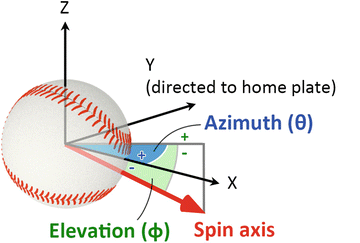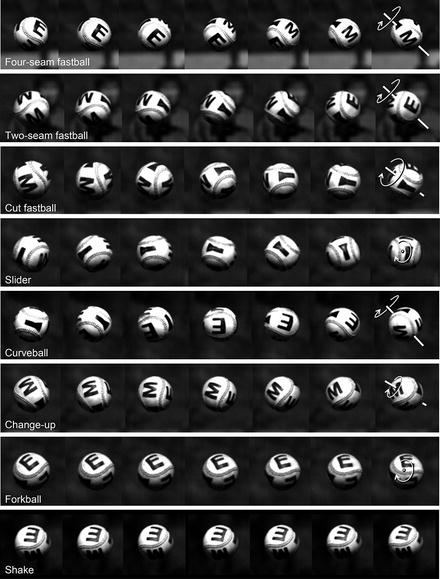Fig. 26.1
Special apparatus to analyze the ball spin

Fig. 26.2
Definition of the angles of elevation Φ and azimuth θ
Ball spin rate just after ball release was calculated from the number of video frames necessary for one rotation of the ball (half rotation for the “shake”): 1,000/number of frames (rotations per second, rps). The direction of the spin axis and the spin rate for each type of pitch were reported as the mean of two pitches.
26.3 Results
Table 26.1 indicates the two components (angles) of the axes together with spin rate and ball speed of eight different pitches. The spin of the “shake” was so slow that the direction of spin axis could not be determined. Direction of spin axis and spin rate both changed considerably depending upon the type of pitch. Figure 26.3 shows changes in the images of ball markers over time. The spin axes are depicted in the rightmost portions of Fig. 26.3

Table 26.1
Direction of spin axis, spin rate, and ball speed for eight different pitches
Pitches | Direction of spin axis | Spin rate | Ball speed | ||||||
|---|---|---|---|---|---|---|---|---|---|
θ | Φ | ||||||||
degree | degree | rps | m/s | (km/h) | |||||
Four-seam fastball | 29 | (30, 28) | −38 | (−39, −37) | 33.9 | (33.3, 34.5) | 37.4 | (37.2, 37.5) | (134, 135) |
Two-seam fastball | 34 | (35, 33) | −40 | (−38, −41) | 31.3 | (31.3, 31.3) | 36.4 | (36.4, 36.4) | (131, 131) |
Cut fastball | 52 | (56, 47) | −22 | (−22, −22) | 35.7 | (35.7, 35.7) | 35.7 | (35.6, 35.8) | (128, 129) |
Slider | 80 | (79, 80) | −4 | (−5, −3) | 38.5 | (38.5, 38.5) | 34.7 | (34.7, 34.7) | (125, 125) |
Curveball | 142 | (139, 145) | 41 | (40, 42) | 44.5 | (45.5, 43.5) | 29.2 | (29.7, 28.6) | (107, 103) |
Change-up | 58 | (58, 58) | −18 | (−18, −19) | 28.2 | (28.6, 27.8) | 29.6 | (28.6, 30.6) | (103, 110) |
Forkball | 84 | (85, 82) | −12 | (−11, −13) | 8.3 | (8.7, 7.9) | 32.8 | (32.8, 32.8) | (118, 118) |
“Shake” | – | – | 2.6 | (3.6, 1.7) | 21.5 | (21.4, 21.7) | (77, 78) | ||

Fig. 26.3
The spin of eight different pitches. Each row contains images just after ball release at 2 ms intervals. The rightmost figures indicate the calculated spin axes
The four-seam and two-seam fastballs were similar in direction of the spin axis, spin rate, and ball speed. The only difference was seam orientation, apparently 4 seams for the four-seam fastball and 2 seams for the two-seam fastball. The slider was unique in that the direction of axis was almost identical with the direction of trajectory, which was 80° in the X-Z plane. The angle of θ was bigger than 90°, indicating a “top spin” only for the curveball. The slider and curveball had a relatively higher spin rate relative to other pitches. The cut fastball showed the spin rate and the direction of spin axis just between those of the four-seam and the slider. Although the direction of spin axis of the change-up was similar to that of the cut fastball, the spin rate and the ball speed were slower than the cut fastball. The direction of spin axis of the forkball was similar to that of the slider, and the spin rate and the ball speed were slower than it. The spin rate and the ball speed of the “shake” were the slowest among the eight pitches.
Stay updated, free articles. Join our Telegram channel

Full access? Get Clinical Tree








